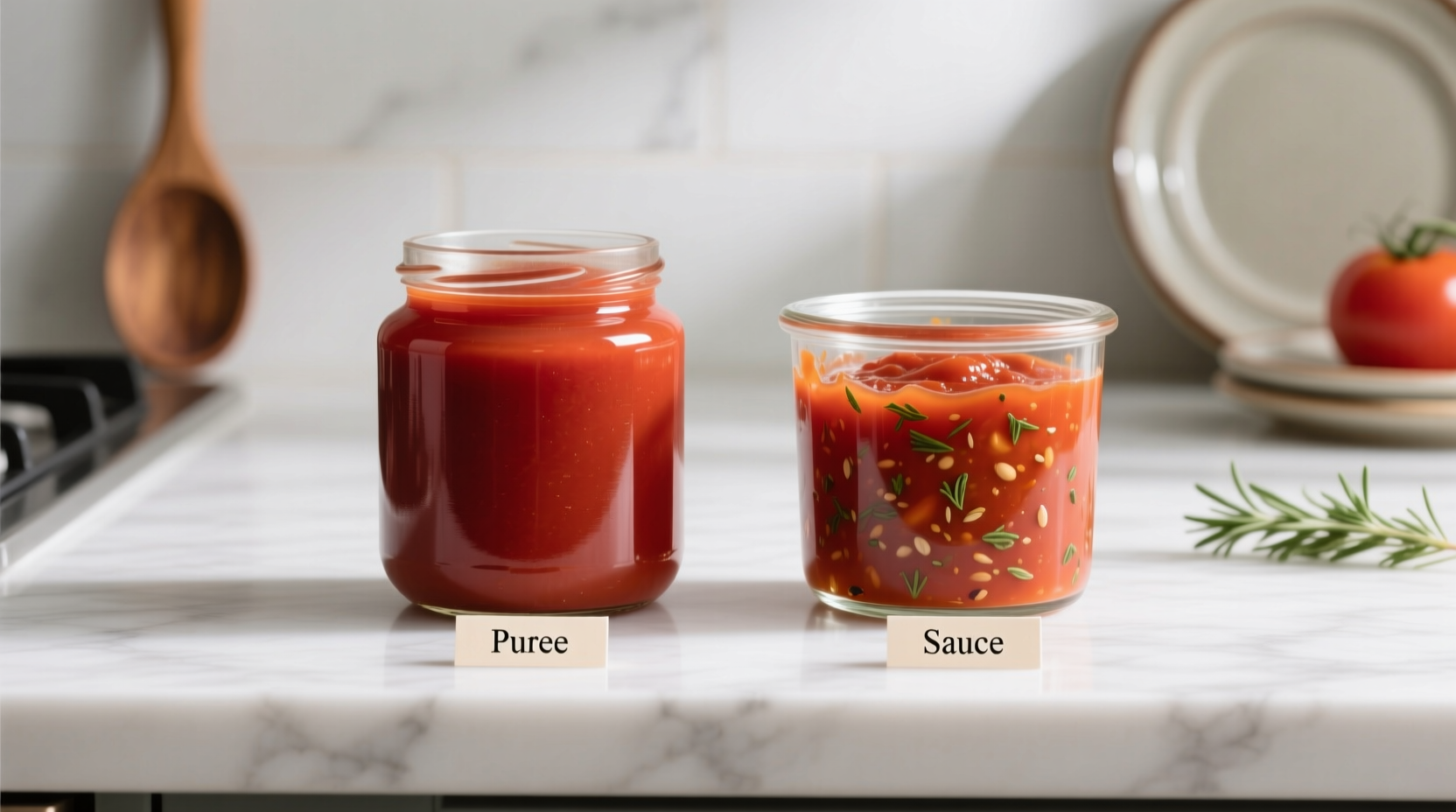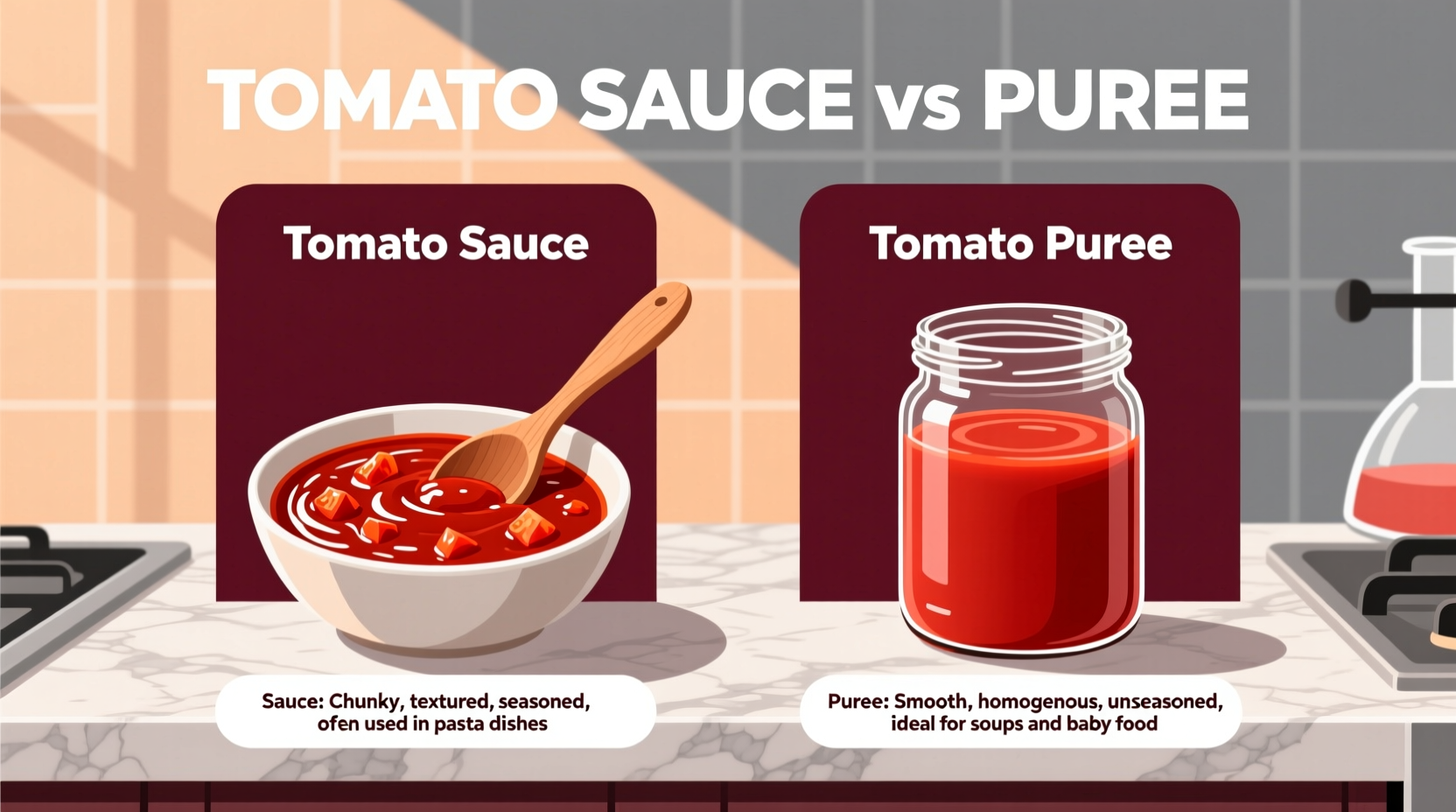Tomato puree is a thick, smooth paste made from cooked and strained tomatoes with no added ingredients, containing 8-24% tomato solids. Tomato sauce is thinner, typically contains added seasonings, herbs, and sometimes sugar, and has only 6-8% tomato solids. Puree serves as a cooking base while sauce is often ready-to-use.
Ever stood in the grocery aisle staring at tomato products, wondering if you're grabbing the right one for your recipe? You're not alone. Understanding the difference between tomato sauce and puree is crucial for achieving perfect results in your cooking. This guide cuts through the confusion with clear, practical information you can use immediately in your kitchen.
What Exactly Sets Them Apart: Core Characteristics
While both products start with tomatoes, their processing methods create distinct culinary tools. Let's examine what makes each unique:
| Characteristic | Tomato Puree | Tomato Sauce |
|---|---|---|
| Tomato Solids Content | 8-24% (thicker consistency) | 6-8% (thinner consistency) |
| Added Ingredients | None (just tomatoes) | Often contains salt, herbs, spices, sometimes sugar |
| Texture | Smooth, dense paste | Thinner, more liquid |
| Flavor Profile | Concentrated tomato flavor | Milder, seasoned taste |
| Primary Culinary Use | Base for sauces, soups, stews | Ready-to-use in recipes with minimal preparation |
This comparison reflects standards established by the Food and Agriculture Organization of the United Nations, which defines tomato puree as "a semi-liquid product obtained from sound ripe tomatoes of which the seeds and skins have been removed" with minimum 8% soluble solids content.

How Processing Creates Different Products
The journey from fresh tomato to shelf-stable product explains much of the difference. Tomato puree undergoes minimal processing: tomatoes are cooked, strained to remove seeds and skins, and concentrated through evaporation. This preserves the intense tomato flavor without dilution.
Tomato sauce takes additional steps. After the initial cooking and straining, manufacturers add seasonings and sometimes thickeners. The Culinary Institute of America notes that commercial tomato sauce typically includes "small quantities of salt, spices, and flavoring ingredients" that transform the base product into something ready for immediate use.
Practical Kitchen Applications: When to Use Which
Knowing when to reach for each product can make or break your dish. Consider these scenarios:
- Use tomato puree when: You're building a complex sauce from scratch, making pizza sauce, or creating a rich tomato-based soup where you control all seasoning
- Use tomato sauce when: You need a convenient base for quick pasta dishes, want consistent flavor without additional seasoning, or need a thinner consistency for certain recipes
Substitution Guidance: Can You Swap Them?
While possible, substitutions require adjustments. If substituting puree for sauce, thin with water (1 part puree to 1 part water). When using sauce instead of puree, you'll need to reduce liquid content and adjust seasonings since sauce already contains added flavors.
Professional chefs like those at the Bon Appétit Test Kitchen recommend against direct substitutions in precision recipes, as the different concentrations significantly impact final texture and flavor balance.
Common Misconceptions Clarified
Several myths persist about these products. First, "tomato paste" is not the same as puree - paste has even higher concentration (24-30% solids). Second, "crushed tomatoes" differ from both, containing larger tomato pieces. Finally, "marinara sauce" is a specific seasoned tomato sauce, not interchangeable with basic tomato sauce.
Reading Labels Like a Pro
When shopping, check ingredient lists carefully. Authentic tomato puree should list only "tomatoes" or "tomato puree." Tomato sauce will include additional ingredients. The USDA requires products labeled as "tomato puree" to contain between 8-24% tomato solids, while "tomato sauce" must contain 6-8%.
Storage and Shelf Life Considerations
Both products share similar storage requirements once opened (refrigerate and use within 5-7 days), but their concentrated nature affects shelf life. Tomato puree's higher solids content gives it slightly longer stability when unopened. Always check for signs of spoilage like off-odors, mold, or significant color changes before use.
FAQ: Frequently Asked Questions
Can I use tomato puree instead of tomato sauce in spaghetti?
Yes, but you'll need to dilute it. Mix 1 part tomato puree with 1 part water and add your preferred seasonings. Puree's concentrated flavor requires adjustment to match sauce's milder profile.
Why does tomato puree have a stronger flavor than sauce?
Tomato puree contains more tomato solids (8-24%) compared to sauce (6-8%), resulting in a more concentrated tomato flavor. Sauce also contains added water and seasonings that dilute the pure tomato taste.
Is tomato puree healthier than tomato sauce?
Puree typically contains no added salt or sugar, making it potentially healthier. However, sauce often includes beneficial ingredients like olive oil and herbs. Check nutrition labels as formulations vary by brand.
What's the difference between tomato puree and crushed tomatoes?
Crushed tomatoes contain larger tomato pieces in a thinner liquid, while puree is completely smooth with higher tomato concentration. Crushed tomatoes have about 6% solids versus puree's 8-24%.











 浙公网安备
33010002000092号
浙公网安备
33010002000092号 浙B2-20120091-4
浙B2-20120091-4